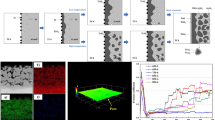Abstract
Microhardness and wear resistance of different microstructures formed by TIG (tungsten inert gas) surface melting and chromium surface alloying (using ferrochromium) of ADI (austempered ductile iron) were studied. Surface melting resulted in the formation of a ledeburitic structure in the melted zone, and this structure has a hardness up to 896 HV as compared to 360 HV in that of ADI. Moreover, chromium surface alloying resulted in the formation of different structures including: (1) a hypereutectic structure consisting of primary (Fe,Cr)7C3 carbides and a eutectic matrix of transformed austenite (into martensite and retained austenite) , as also (Fe,Cr)7C3 carbides, with a hardness of 1078 HV; (2) a hypoeutectic structure consisting of the same eutectic along with transformed primary austenite, with a hardness of 755 HV; and (3) a ledeburitic structure with an acicular morphology and a hardness of 896 HV. The results also indicated that surface melting reduced the wear rate of the ADI by approximately 37%. Also, chromium surface alloying yielded a superior wear behavior and reduced the wear rate of the treated specimens by about 38% and 70%, depending on the structures formed.
Similar content being viewed by others
References
Hayrynen K L, Brandenberg K R, Keough J R. Austempered Gears and Shafts: Tough Solutions [J]. Gear Technology, 2001, 18 (2): 42.
Qian M, Harada S, Kuroshima Y, Nagayoshi H. Surface Hardening of Ductile Cast Iron Using Stainless Steel [J]. Material Science and Engineering, 1996, 208A (1): 88.
Nagai T, Fujioka J, Hattori H, et al. Iron Casting With Mo-Alloyed and W-Alloyed for Wear Resistance and Laser Surface Modification-Laser Surface Modification of Cast Iron Aimed at Refining the Wear Resistance [J]. Yosetsu Gakkai Ronbunshu/Quarterly Journal of the Japan Welding Society, 2004, 22 (1): 132 (in Japanese).
Sohi M H, Kasrshenas G, Boutorabi S M A. Electron Beam Surface Melting of As Cast and Austempered Ductile Irons [J]. Journal of Materials Processing Technology, 2004, 153–154(1–3): 199.
Grum J, Sturm R. Microstructure Analysis of Nodular Iron 400–12 After Laser Surface Melt Hardening [J]. Materials Characterization, 1996, 36 (2–3): 81.
Roy A, Manna I. Laser Surface Engineering to Improve Wear Resistance of Austempered Ductile Iron [J]. Materials Science and Engineering, 2001, A297 (1–2): 85.
Benyounis K Y, Fakron O M A, Abboud J H, et al. Surface Melting of Nodular Cast Iron by Nd-YAG Laser and TIG [J]. Journal of Materials Processing Technology, 2005, 170(1–2): 127.
Hiraoka T, Nakamora Y, Tanaka Y. Mechanical Properties of Cast Iron Surface-Hardened by TIG Arc Remelting [J]. Transactions of the American Foundrymen’s Society, 1995, (102): 603.
Wladyslaw A, Orlowicz, Trytek A. Susceptibility of Iron Castings to Heat Absorption From an Electric Arc and to Hardened-Layer Shaping [J]. Metallurgical and Materials Transactions A: Physical Metallurgy and Materials Science, 2003, 34A (12): 2973.
Gioradno L, Tiziani A, Zambon A. Characterization of Surface Chromium and Molybdenum Alloying on Gray Cast Iron Obtained by the Plasma-Transferred Arc Technique [J]. Material Science and Engineering, 1991, A140 (1–2): 727.
Tomlinson W J, Cash M, Bransden A S. Dry Sliding Wear of Grey Iron Laser Surface Alloyed With 14%–40% Chromium [J]. Wear, 1991, 142 (2): 383.
Park H, Nakata K, Tomida S. In Situ Formation of TiC Particulate Composite Layer on Cast Iron by Laser Alloying of Thermal Sprayed Titanium Coating [J]. Journal of Material Science, 2000, 35 (3): 747.
Bedolla-Jacuinde A, Correa R, Quezada J G, et al. Effect of Titanium on the As-Cast Microstructure of a 16% Chromium White Iron [J]. Materials Science and Engineering, 2005, 398A (1–2), 297.
Svensson L E, Gretoft B, Ulander B, et al. Fe-Cr-C Hardfacing Alloys for High Temperature Applications [J]. Journal of Materials Science, 1986, 12 (3): 1015.
Eroglu M, Zdemir N O. Tungsten-Inert Gas Surface Alloying of a Low Carbon Steel [J]. Surface and Coating Technology, 2002, 154 (2–3): 209.
Yun E, Lee S. Improvement of Hardness and Wear Resistance in Stainless-Steel-Based Surface Composites Fabricated by High-Energy Electron Beam Irradiation [J]. Surface and Coatings Technology, 2006, 200 (11): 3478.
Hutchings I M. Tribology: Friction and Wear of Engineering Materials [J]. Cambridge: Edward Arnold, 1992.
Author information
Authors and Affiliations
Corresponding author
Rights and permissions
About this article
Cite this article
Amirsadeghi, A., Sohi, M.H. & Bozorg, S.F.K. Effects of TIG surface melting and chromium surface alloying on microstructure, hardness and wear resistance of ADI. J. Iron Steel Res. Int. 15, 86–94 (2008). https://doi.org/10.1016/S1006-706X(08)60150-8
Revised:
Published:
Issue Date:
DOI: https://doi.org/10.1016/S1006-706X(08)60150-8




